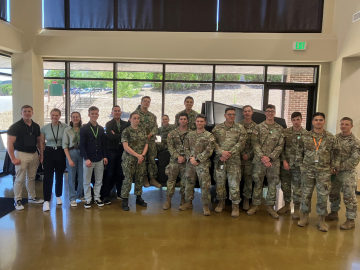
Filter News
Area of Research
- Advanced Manufacturing (1)
- Biology and Environment (24)
- Clean Energy (15)
- Computational Biology (1)
- Computer Science (2)
- Fuel Cycle Science and Technology (1)
- Fusion and Fission (2)
- Isotopes (2)
- Materials (30)
- Materials for Computing (6)
- National Security (31)
- Neutron Science (14)
- Nuclear Science and Technology (4)
- Quantum information Science (1)
- Supercomputing (57)
News Type
News Topics
- (-) Computer Science (92)
- (-) Exascale Computing (27)
- (-) Materials Science (56)
- (-) Mercury (7)
- (-) National Security (48)
- (-) Polymers (11)
- (-) Transformational Challenge Reactor (3)
- 3-D Printing/Advanced Manufacturing (46)
- Advanced Reactors (9)
- Artificial Intelligence (50)
- Big Data (32)
- Bioenergy (52)
- Biology (61)
- Biomedical (31)
- Biotechnology (13)
- Buildings (26)
- Chemical Sciences (29)
- Clean Water (16)
- Climate Change (56)
- Composites (9)
- Coronavirus (18)
- Critical Materials (6)
- Cybersecurity (14)
- Decarbonization (50)
- Education (1)
- Emergency (2)
- Energy Storage (36)
- Environment (111)
- Fossil Energy (4)
- Frontier (26)
- Fusion (33)
- Grid (28)
- High-Performance Computing (46)
- Hydropower (5)
- Isotopes (30)
- ITER (2)
- Machine Learning (23)
- Materials (45)
- Mathematics (7)
- Microelectronics (3)
- Microscopy (23)
- Molten Salt (1)
- Nanotechnology (20)
- Net Zero (8)
- Neutron Science (52)
- Nuclear Energy (61)
- Partnerships (19)
- Physics (35)
- Quantum Computing (22)
- Quantum Science (32)
- Renewable Energy (1)
- Security (13)
- Simulation (32)
- Software (1)
- Space Exploration (12)
- Statistics (1)
- Summit (31)
- Sustainable Energy (51)
- Transportation (32)
Media Contacts

Elton Aba an intern at the Department of Energy’s Oak Ridge National Laboratory, collaborated with researchers to explore an intriguing intersection: how biology can inform cybersecurity. Aba shared some of his findings on how biomimicry could help secure our nation’s critical infrastructure.

Mohamad Zineddin, a distinguished researcher in nuclear and radiological engineering, recently received the Roger Howsley Award for Excellence in Nuclear Security.

Researchers at ORNL are using satellite images of homes under construction to address gaps in census data, especially in areas like Sub-Saharan Africa. By analyzing these images, they estimate dwelling sizes and population densities where traditional data is sparse. This method improves population estimates and supports national security by enhancing emergency response capabilities.

A study found that beaches with manmade fortifications recover more slowly from hurricanes than natural beaches, losing more sand and vegetation. The researchers used satellite images and light detection and ranging data, or LIDAR, to measure elevation changes and vegetation coverage. Changes in elevation showed how much sand was depleted during the storm and how much sand returned throughout the following year.

At ORNL, a group of scientists used neutron scattering techniques to investigate a relatively new functional material called a Weyl semimetal. These Weyl fermions move very quickly in a material and can carry electrical charge at room temperature. Scientists think that Weyl semimetals, if used in future electronics, could allow electricity to flow more efficiently and enable more energy-efficient computers and other electronic devices.

Benjamin Manard, an analytical chemist in the Chemical Sciences Division of the Department of Energy’s Oak Ridge National Laboratory, will receive the 2024 Lester W. Strock Award from the Society of Applied Spectroscopy.

Ten future U.S. Army officers recently visited ORNL to learn about the legacy of nuclear science. As students of the Nuclear Science and Engineering Research Center, or NSERC, with the Defense Threat Reduction Agency, or DTRA, they stopped in East Tennessee as part of a larger tour across nuclear facilities supporting the military. In Oak Ridge, they visited ORNL to gain an appreciation of the history of the Manhattan Project and how research at a national lab contributes new materials and electronics for the nuclear industry.

The world’s fastest supercomputer helped researchers simulate synthesizing a material harder and tougher than a diamond — or any other substance on Earth. The study used Frontier to predict the likeliest strategy to synthesize such a material, thought to exist so far only within the interiors of giant exoplanets, or planets beyond our solar system.
Joe Tuccillo, a human geography research scientist, leads the UrbanPop project that uses census data to create synthetic populations. Using a Python software suite called Likeness on ORNL’s high-performance computers, Tuccillo’s team generates a population with individual ‘agents’ designed to represent people that interact with other agents, facilities and services in a simulated neighborhood.

Two ORNL teams recently completed Cohort 18 of Energy I-Corps, an immersive two-month training program where the scientists define their technology’s value propositions, conduct stakeholder discovery interviews and develop viable market pathways.


